句法研究
词法和句法
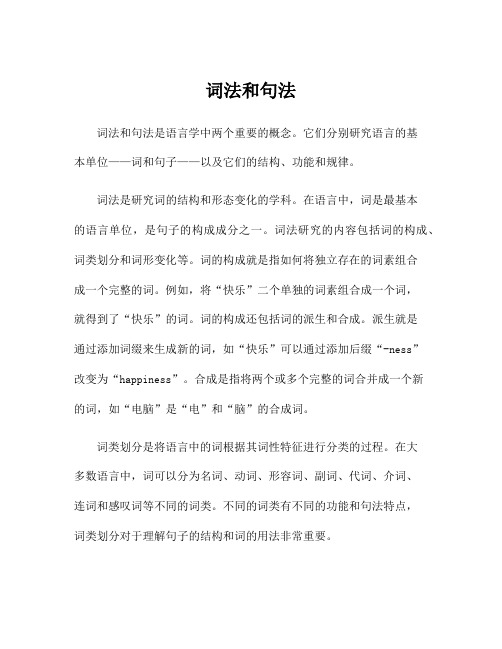
词法和句法词法和句法是语言学中两个重要的概念。
它们分别研究语言的基本单位——词和句子——以及它们的结构、功能和规律。
词法是研究词的结构和形态变化的学科。
在语言中,词是最基本的语言单位,是句子的构成成分之一。
词法研究的内容包括词的构成、词类划分和词形变化等。
词的构成就是指如何将独立存在的词素组合成一个完整的词。
例如,将“快乐”二个单独的词素组合成一个词,就得到了“快乐”的词。
词的构成还包括词的派生和合成。
派生就是通过添加词缀来生成新的词,如“快乐”可以通过添加后缀“-ness”改变为“happiness”。
合成是指将两个或多个完整的词合并成一个新的词,如“电脑”是“电”和“脑”的合成词。
词类划分是将语言中的词根据其词性特征进行分类的过程。
在大多数语言中,词可以分为名词、动词、形容词、副词、代词、介词、连词和感叹词等不同的词类。
不同的词类有不同的功能和句法特点,词类划分对于理解句子的结构和词的用法非常重要。
词形变化是指词在不同语法环境下经历词形变化的现象。
例如,汉语的动词在时态和语态上经历了变化,如“跑”在过去时变为“跑了”,在被动语态中变为“被跑”。
英语的动词则会变化形式来表示人称和数,如“go”的第三人称单数形式是“goes”。
词形变化是语言中非常重要的一部分,它能够表达丰富的语法信息。
句法则是研究句子的结构和句子内部成分之间的关系的学科。
句法研究的内容包括短语结构、句法功能和句子成分等。
短语结构研究的是句子的组成成分和它们的排列方式。
例如,英语中的句子通常由主语、谓语和宾语组成,这些成分的限制和排列顺序需要遵循一定的句法规则。
句法功能研究的是句子的成分在句子中所起的作用,如主语是句子的话题,宾语是句子的动作承受者等。
句子成分研究的是句子内部各个成分之间的关系,如动词和宾语的关系、形容词和名词的关系等。
词法和句法是紧密联系的。
词法研究的是词的构成和变化,而句法研究的是词的组合和排列。
词法提供了句法分析的基础,使我们能够理解词在句子中的用法和意义。
句法研究的认知观视角及认知法句法教学
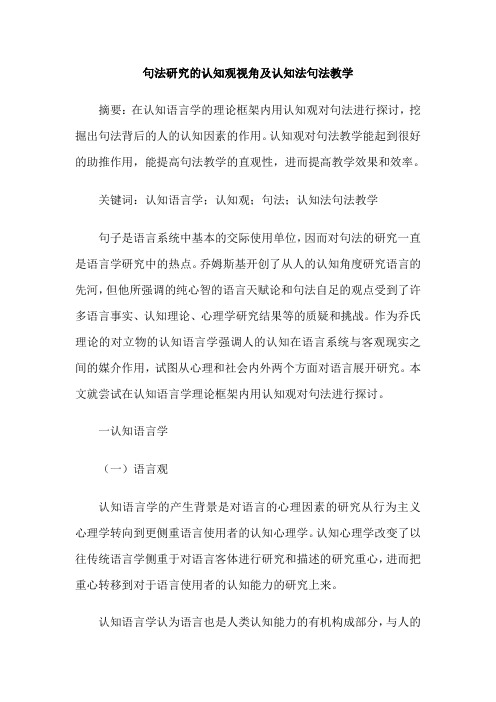
句法研究的认知观视角及认知法句法教学摘要:在认知语言学的理论框架内用认知观对句法进行探讨,挖掘出句法背后的人的认知因素的作用。
认知观对句法教学能起到很好的助推作用,能提高句法教学的直观性,进而提高教学效果和效率。
关键词:认知语言学;认知观;句法;认知法句法教学句子是语言系统中基本的交际使用单位,因而对句法的研究一直是语言学研究中的热点。
乔姆斯基开创了从人的认知角度研究语言的先河,但他所强调的纯心智的语言天赋论和句法自足的观点受到了许多语言事实、认知理论、心理学研究结果等的质疑和挑战。
作为乔氏理论的对立物的认知语言学强调人的认知在语言系统与客观现实之间的媒介作用,试图从心理和社会内外两个方面对语言展开研究。
本文就尝试在认知语言学理论框架内用认知观对句法进行探讨。
一认知语言学(一)语言观认知语言学的产生背景是对语言的心理因素的研究从行为主义心理学转向到更侧重语言使用者的认知心理学。
认知心理学改变了以往传统语言学侧重于对语言客体进行研究和描述的研究重心,进而把重心转移到对于语言使用者的认知能力的研究上来。
认知语言学认为语言也是人类认知能力的有机构成部分,与人的其它认知能力没有什么差别。
认知是语言的基础,具有前语言阶段,是决定性的;语言是认知的窗口,能促进认知的发展。
它着重于研究和揭示语言使用者的主观倾向对语言使用的影响。
客观经验主义指导下的认知语言学认为,语言不是直接对应于并直接反映现实世界的,在这个过程中,人的认知充当了媒介和过滤器,即“语言一认知一客观世界”,即是说,语言并不直接反映外部现实世界,语言中描述的客观世界只是客观世界通过人的认知在语言系统中的映射,任何语言中描述的客观世界都有语言使用者的主观选择和评价,人类通过语言对客观世界进行着主观化的描述和理解。
不同的语言使用者由于个体的认知能力、认知模式、认知视角、认知经验和文化背景等因素的不同,会对客观世界有不同的描述和理解。
认知语言学认为语义结构才是语言研究的重点。
汉语句法的认知结构研究

汉语句法的认知结构研究随着语言学研究的深入,汉语句法的认知结构逐渐成为的焦点。
这一研究领域对于理解汉语语言现象、提高汉语教学水平以及推进汉语语言技术的发展都具有重要意义。
本文将从观点阐述、认知结构分析、案例分析等方面,探讨汉语句法的认知结构。
在汉语句法结构方面,汉语是一种注重意合的语言,其句法关系主要通过语义关系来体现。
与印欧语不同,汉语中词的顺序、虚词的使用都较为灵活,而句法结构的核心是句法成分的组合关系。
在认知语言学看来,汉语的句法结构具有“以意役形”的特点,即意义决定形式。
在汉语句法认知结构分析方面,句法成分、结构关系和认知模型是三个核心要素。
句法成分是指句子中的不同成分,如主语、谓语、宾语、定语等,这些成分在句子中承担不同的意义和功能。
结构关系是指句子中各成分之间的相互关系,包括层次关系和平行关系。
认知模型是人们对语言结构认知的过程和结果,它反映了人们对语言结构的理解和记忆方式。
具体案例分析方面,我们以一个简单句“他喜欢吃苹果”为例。
在这个句子中,“他”是主语,“喜欢”是谓语,“吃苹果”是宾语。
这三个成分之间通过动宾结构关系组合在一起,表达了一个完整的意义。
人们在对这个句子进行认知加工时,会首先提取出句子的主要信息“他喜欢”,然后根据动宾结构的语义关系,推断出“吃苹果”这一动作行为。
汉语句法的认知结构研究对于深入理解汉语语言现象具有重要意义。
通过对汉语句法成分、结构关系和认知模型的分析,我们可以更好地理解汉语的语法规则和语义表达方式,为汉语教学和语言技术的发展提供理论支持和实践指导。
未来,随着汉语句法认知结构研究的不断深入,我们有望在汉语语言理解和生成方面取得更大的突破。
汉语作为一门悠久而丰富的语言,其句法结构和对外汉语教学都是非常重要的话题。
汉语句法结构是构成汉语句子的基础,而对外汉语教学则是帮助学习者有效掌握汉语的重要途径。
本文将探讨汉语句法结构与对外汉语教学之间的关系,以期为汉语学习者提供更好的指导。
语言学中的句法分析

语言学中的句法分析语言是人类最重要的交流工具之一,它通过词汇和语法来传达思想和意义。
在语言学中,句法分析是一项重要的研究领域,旨在理解和描述句子的结构和组成成分。
本文将介绍句法分析的基本概念和方法,并探讨其在语言学和人工智能领域的应用。
一、句法分析的基本概念句法分析是研究句子结构的学科,它关注句子中的词汇和它们之间的关系。
在句法分析中,句子被看作是由词汇和短语组成的,而这些词汇和短语之间的关系可以通过语法规则来描述。
句法分析的目标是确定句子的句法结构,即句子中各个成分之间的关系和层次。
二、句法分析的方法句法分析有多种方法,包括基于规则的方法、基于统计的方法和基于机器学习的方法。
基于规则的方法是最早的句法分析方法之一,它通过定义一系列语法规则来分析句子的结构。
这些规则可以是基于语言学知识的,也可以是基于实际语料库的。
基于统计的方法则是通过分析大量的语料库数据来学习句子的结构和语法规则。
这些方法使用统计模型来预测句子中不同成分之间的关系。
基于机器学习的方法则是将机器学习算法应用于句法分析任务中,通过训练模型来预测句子的句法结构。
三、句法分析的应用句法分析在语言学和人工智能领域有着广泛的应用。
在语言学中,句法分析可以帮助研究者理解不同语言的句法结构和语法规则。
通过分析句子的句法结构,语言学家可以揭示出不同语言之间的共性和差异,进一步探索语言的本质和演化。
在人工智能领域,句法分析是自然语言处理和机器翻译等任务的基础。
通过对句子的句法结构进行分析,计算机可以更好地理解和处理自然语言,从而实现自动翻译、问答系统等人机交互的应用。
四、句法分析的挑战和发展尽管句法分析在理论和应用方面取得了一些进展,但仍然面临着一些挑战。
首先,不同语言之间的句法结构和语法规则存在差异,这给跨语言句法分析带来了困难。
其次,句法分析需要处理大量的语言数据,包括语料库和语法规则,这对计算资源和算法效率提出了要求。
此外,句法分析还需要解决歧义和多义性等问题,以确保准确分析句子的结构。
语法研究的三个方面
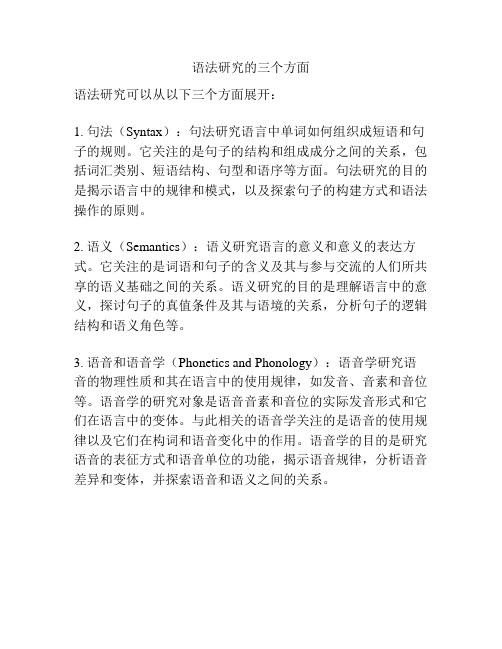
语法研究的三个方面
语法研究可以从以下三个方面展开:
1. 句法(Syntax):句法研究语言中单词如何组织成短语和句子的规则。
它关注的是句子的结构和组成成分之间的关系,包括词汇类别、短语结构、句型和语序等方面。
句法研究的目的是揭示语言中的规律和模式,以及探索句子的构建方式和语法操作的原则。
2. 语义(Semantics):语义研究语言的意义和意义的表达方式。
它关注的是词语和句子的含义及其与参与交流的人们所共享的语义基础之间的关系。
语义研究的目的是理解语言中的意义,探讨句子的真值条件及其与语境的关系,分析句子的逻辑结构和语义角色等。
3. 语音和语音学(Phonetics and Phonology):语音学研究语音的物理性质和其在语言中的使用规律,如发音、音素和音位等。
语音学的研究对象是语音音素和音位的实际发音形式和它们在语言中的变体。
与此相关的语音学关注的是语音的使用规律以及它们在构词和语音变化中的作用。
语音学的目的是研究语音的表征方式和语音单位的功能,揭示语音规律,分析语音差异和变体,并探索语音和语义之间的关系。
系统功能语言学的句法研究

系统功能语言学的句法研究一、引言系统功能语言学,简称SFL是由英国语言学家哈利·J. 鲁德尔于20世纪60年代提出的一种社会语言学。
在该理论体系下,句法是语言的一个重要层面,包括了结构化规则、语言功能等方面。
本文将针对系统功能语言学的句法研究进行深入探究。
二、系统功能语言学系统功能语言学通过对语言系统进行分类,描绘语言的构造过程,推导语言规则,来理解语言的功能。
在SFL中,不同的语言单位被分为三种:言语行为、语篇、句子。
每个语言单位在具体使用中又可以发挥不同的功能,包括宣示(表示现实)、交际(建立联系)、表达(传递情感)等。
这些功能的使用是在语言单位间互相影响、互相制约的。
三、SFL的句法研究SFL的句法研究包括两个方面:结构化分类和功能分类。
针对前者,SFL将句子的结构分为了简单句、并列句、复合句、主从复合句等几种类型;针对后者,则将句子的功能分为了角色、情境、话语等几个方面。
同时,SFL也指出了句子构造中词汇与语法的互相作用、动态变化的关系,这些都为句法研究提供了新的思路。
四、案例分析以英语为例,SFL的句法研究为我们提供了新颖的观察视角。
例如,以下句子:The boy threw the ball.我们可以将其拆分为主语(the boy)、谓语(threw)和宾语(the ball)三部分,然后进一步划分它们的语法角色,如主语扮演了代词、名词短语、复合名词等几个角色;从句谓语的时态、完整性等因素影响了其在情境中的作用等等。
这种分类方法可以帮助我们更好地分析句子,理解其所承载的信息。
五、结论系统功能语言学的句法研究丰富了我们对语言的认识,为我们理解语言构造和选择、使用语言的意图提供了新的思路。
在句法研究中,不仅可以深入剖析语言单位之间的关系,还可以考虑到其在社会、人际交往中的作用,更好地理解和应用语言。
句法 名词解释
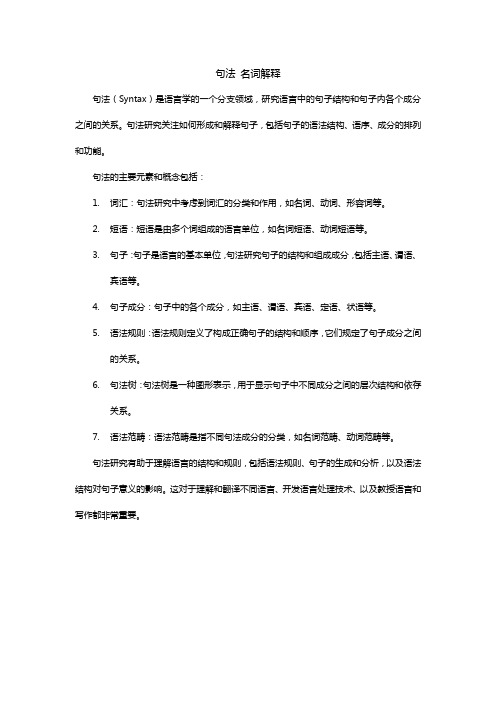
句法名词解释
句法(Syntax)是语言学的一个分支领域,研究语言中的句子结构和句子内各个成分之间的关系。
句法研究关注如何形成和解释句子,包括句子的语法结构、语序、成分的排列和功能。
句法的主要元素和概念包括:
1.词汇:句法研究中考虑到词汇的分类和作用,如名词、动词、形容词等。
2.短语:短语是由多个词组成的语言单位,如名词短语、动词短语等。
3.句子:句子是语言的基本单位,句法研究句子的结构和组成成分,包括主语、谓语、
宾语等。
4.句子成分:句子中的各个成分,如主语、谓语、宾语、定语、状语等。
5.语法规则:语法规则定义了构成正确句子的结构和顺序,它们规定了句子成分之间
的关系。
6.句法树:句法树是一种图形表示,用于显示句子中不同成分之间的层次结构和依存
关系。
7.语法范畴:语法范畴是指不同句法成分的分类,如名词范畴、动词范畴等。
句法研究有助于理解语言的结构和规则,包括语法规则、句子的生成和分析,以及语法结构对句子意义的影响。
这对于理解和翻译不同语言、开发语言处理技术、以及教授语言和写作都非常重要。
基于规则的汉语句法分析方法研究

基于规则的汉语句法分析方法研究
1.规则的制定:基于规则的汉语句法分析方法需要制定规则来描述句法结构和语法规则。
这些规则可以基于语法书写和语言学理论,也可以基于语料库分析和统计学方法。
2.句法分析算法:基于规则的方法通常使用自顶向下或自底向上的算法来进行句法分析。
自顶向下的方法从句子的整体结构出发,逐步细化到句子的具体成分;自底向上的方法则从句子的具体成分出发,逐步构建出句子的整体结构。
3.语法知识库的构建:基于规则的方法需要构建和维护一个语法知识库,包括词汇和语法规则。
这个知识库可以基于现有的语言学知识和语法书写,也可以通过自动学习和信息提取技术进行构建。
4.语言现象的处理:基于规则的方法需要考虑各种语言现象的处理,如歧义、省略、主语短语的识别等。
这些处理需要基于语法规则和理论来进行分析和解决。
汉语句法中的小句结构研究

汉语句法中的小句结构研究汉语是一门非常复杂的语言,它的语法体系也是十分庞大的。
其中,句法是汉语语法中的一个重要部分。
在汉语的句法系统中,小句结构是常见的一种结构。
小句结构在汉语的修辞手法中也具有重要作用。
本文将对汉语句法中的小句结构进行研究。
一、小句结构的定义小句是语言中最小的语义单位,它是构成长句的重要组成部分。
小句结构是由主语、谓语和宾语组成的独立语言结构,它可以作为长句中的一个语法成分,也可以单独使用。
在汉语中,小句结构主要指的是不带有主谓宾结构的句子。
小句结构通常由主语和状语组成。
这种语言结构通常用于表示一种状态或者情感。
二、小句结构的种类及其特点1、主谓结构主谓结构是汉语小句结构中最基本的结构。
它由主语和谓语组成。
主语通常是一个词或短语,用来表示句子主要讨论的话题,谓语则是描述主语的动作或状态。
例如:“我爱你”。
这个句子中,“我”作为主语,“爱”作为谓语,表示主语的情感。
2、并列结构并列结构是由两个或以上小句通过一个连接词连接而成的句子。
这种结构通常表示对事物的偏向或者对相似或相反事物的比较。
例如:“他很高兴,我很难过。
”这个句子中,通过“和”连接了两个小句,表示了两个不同的情感。
3、状语从句结构状语从句结构是在主句中嵌入一个从句,用来修饰主句中动词的时间、原因或目的。
例如:“因为下雨,他没有去上班。
”这个句子中,“因为下雨”是一个状语从句,修饰了主句中的“没有去上班”这个动作。
4、双宾结构双宾结构是指有两个宾语的小句结构。
其中一个宾语是直接宾语,指的是直接接受动作的人或物,另一个是间接宾语,表示动作的对象或目标。
例如:“我给你一本书。
”这个句子中,“一本书”是直接宾语,“你”是间接宾语。
三、小句结构在汉语修辞中的应用小句结构在汉语修辞中具有重要的作用。
通过采用不同的小句结构,可以达到不同的修辞效果。
其中,状语从句结构可以用来加强语气,强调主句中的动作。
例如:“虽然天气很热,但是我还是要坚持运动。
语言学研究中的句法分析

语言学研究中的句法分析语言学是一门研究语言的学科,它涉及到的范围包括语音、语法、语义、词汇等多个方面,其中语法是语言学研究的重点之一。
语法是研究句子结构和句子成分之间的关系的学科,而句法分析则是语法研究的重要方法。
一、语法与句法语法是研究句子结构和句子成分之间的关系的学科。
句子是语言交流的基本单位,而语法是研究句子的构成和组成规则的学科。
语法的研究旨在揭示语言形式和语言意义的内在关系,即探讨语言形式和语言意义之间的规律性联系。
语法的基本研究对象是词和句子。
词是语言中最小的有意义的单元,而句子是语言中彰显语用功能的最大单位。
词汇是句子的组成部分,而句法则是句子构成的整体规则。
句法是语法的一部分,它是研究句子结构和句子成分之间的关系的学科。
句法的研究内容包括如何识别句子的成分、如何分析句子的结构和句子中不同成分的关系等。
句法研究可以帮助我们更好地理解句子的意义和理解句子的构成规则,从而更好地掌握语言的表达能力和理解能力。
二、句法分析方法句法分析是指通过分析句子结构和成分之间的关系来解释句子的意义。
句法分析方法的主要有两种:依存句法分析和短语结构句法分析。
依存句法分析主要关注的是句子中各个成分之间的依存关系。
依存关系指的是一个成分与它所依赖的成分之间的关系。
例如,在句子“I love you”中,主语“I”是动词“love”的依存成分,宾语“you”也是动词“love”的依存成分。
通过识别句子中各个成分之间的依存关系,可以更好地理解句子的结构和意义。
短语结构句法分析主要关注的是句子结构的组成和分析。
短语结构句法分析的基本思路是将句子分解为各个“组块”,然后再将这些组块拼接成一个完整的句子。
例如,在句子“I love you”中,可以将其分解为“NP(I)VP(love you)”的形式。
这个分解结果表示主语“I”和动词短语“love you”构成了一个完整的句子。
通过短语结构的分析,可以更好地理解句子的构成规则和句子中各个成分之间的关系。
生成语法视角下的现代汉语“句法”结构研究

生成语法视角下的现代汉语“句法”结构研究摘要本文旨在通过生成语法视角探讨现代汉语的句法结构。
生成语法作为一种语言分析理论,可以系统地描述句子的结构和生成过程。
在对现代汉语进行研究时,生成语法可以帮助我们理解汉语句子的形成过程、句子内部成分之间的关系以及句子的语义表达方式。
本文将从生成语法的角度出发,探讨现代汉语句法结构的研究方法、主要内容和研究意义。
1. 引言随着汉语研究的不断深入,对现代汉语句法结构的研究也越来越受到关注。
传统的语法分析方法往往局限于表面结构的描述,难以全面理解句子内部的组成和句子形成的规律。
而生成语法作为一种形式化的语法分析方法,可以通过生成规则、转换规则和语义规则等来描述句子的结构和生成过程,从而更好地解释句子内部成分之间的关系和语义含义。
2. 生成语法在汉语句法研究中的应用生成语法的出现为汉语句法研究提供了新的分析工具和方法。
通过生成语法,我们可以深入分析汉语句子的组成部分,包括短语、动词短语、句子成分等。
同时,生成语法还可以揭示句子结构的发展历程,即句子是如何形成的过程。
通过对句子的生成规则和转换规则的分析,我们可以更好地理解汉语句子的语法结构和语义表达方式。
3. 生成语法在现代汉语研究中的意义生成语法在现代汉语研究中具有重要的意义。
首先,通过生成语法,我们可以更深入地理解现代汉语句子内部成分之间的关系。
生成分析可以揭示句子中各个成分的生成和转换过程,帮助我们理解句子的结构和语义含义。
其次,生成语法可以提供一种系统的研究框架,帮助我们探索现代汉语句子的生成规律和语义表达方式。
最后,生成语法在语言教学中也有重要的应用价值,可以帮助研究者更准确地理解汉语句子的结构和语义。
4. 研究方法和主要内容本文将采用文献综述的方法,通过梳理相关文献并分析研究方法和主要内容,对生成语法视角下现代汉语句法结构的研究进行总结和归纳。
主要内容包括生成语法的基本原理和分析方法、汉语句子的生成规则和转换规则、汉语句子内部成分的生成过程和语义表达方式等。
谈现代语言学四大视角下的句法研究
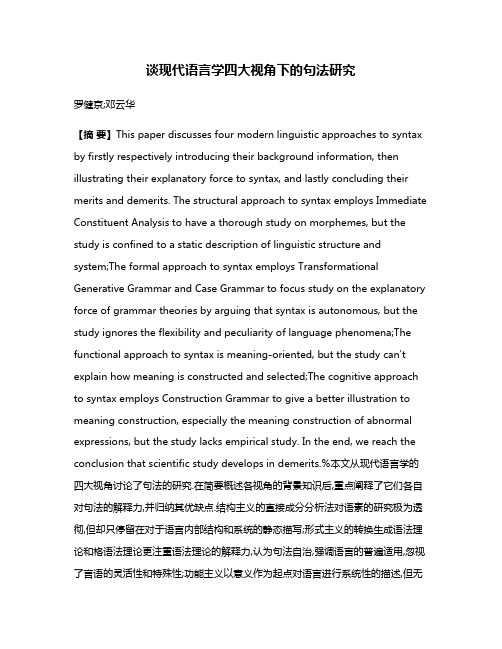
谈现代语言学四大视角下的句法研究罗健京;邓云华【摘要】This paper discusses four modern linguistic approaches to syntax by firstly respectively introducing their background information, then illustrating their explanatory force to syntax, and lastly concluding their merits and demerits. The structural approach to syntax employs Immediate Constituent Analysis to have a thorough study on morphemes, but the study is confined to a static description of linguistic structure and system;The formal approach to syntax employs Transformational Generative Grammar and Case Grammar to focus study on the explanatory force of grammar theories by arguing that syntax is autonomous, but the study ignores the flexibility and peculiarity of language phenomena;The functional approach to syntax is meaning-oriented, but the study can't explain how meaning is constructed and selected;The cognitive approach to syntax employs Construction Grammar to give a better illustration to meaning construction, especially the meaning construction of abnormal expressions, but the study lacks empirical study. In the end, we reach the conclusion that scientific study develops in demerits.%本文从现代语言学的四大视角讨论了句法的研究.在简要概述各视角的背景知识后,重点阐释了它们各自对句法的解释力,并归纳其优缺点.结构主义的直接成分分析法对语素的研究极为透彻,但却只停留在对于语言内部结构和系统的静态描写;形式主义的转换生成语法理论和格语法理论更注重语法理论的解释力,认为句法自治,强调语言的普遍适用,忽视了言语的灵活性和特殊性;功能主义以意义作为起点对语言进行系统性的描述,但无法解释语义是如何产生的以及如何对语义进行选择的问题;认知主义的构式语法理论更好地解释了意义的建构过程,尤其是超常表达的意义建构,但缺乏科学实证性.最后得出结论,科学研究在不足中发展.【期刊名称】《湖南工业职业技术学院学报》【年(卷),期】2015(015)005【总页数】5页(P27-31)【关键词】结构主义;形式主义;功能主义;认知主义;句法【作者】罗健京;邓云华【作者单位】湖南师范大学外国语学院,湖南长沙,410081;湖南师范大学外国语学院,湖南长沙,410081【正文语种】中文【中图分类】H314.3谈现代语言学四大视角下的句法研究罗健京,邓云华(湖南师范大学外国语学院,湖南长沙,410081)[摘要]本文从现代语言学的四大视角讨论了句法的研究。
句法学研究历史

句法学句法学Syntax研究语言的句子结构。
该语言学术语来自希腊语,字意是排列。
句子是根据一种特定的排列词的方式构成的。
排列正确的句子被认为是合乎语法的句子。
合乎语法的句子是根据一套句法规则构成的。
句法是一个规则系统。
句法是一个由一套数量有限的抽象规则组成的系统,句子由单词组合而成。
句子的语法性是指句子的合成必须符合操本族语者头脑中的语法知识。
任何一种语言的句法规则都包含了说话者的头脑中的语言知识系统(被称为语言能力)。
任何语言的句法规则的数量是有限的,但说话者可以理解和表达的句子的数量是无限的。
俄罗斯的句法学研究有着悠久的历史和自成体系的传统。
19世纪的沃斯托科夫(А. Х. Востоков)、福尔图纳托夫(Ф. Ф. Фортунатов)和沙赫马托夫(А. А. Шахматов)等俄罗斯语言学家就已经把句法学看作是一个独立的语言学分支学科,认为其主要任务是研究词语的组合关系。
但是,他们的句法研究以词组中的语法支配关系为中心,对于句子层面上的句法结构和语义结构并未给予充分重视。
20世纪中叶,维诺格拉多夫院士奠定了现代俄语句法学的基础。
他明确指出,句法研究的对象是作为独立交际单位的句子。
句子有三个基本特征:交际语调、述谓性和情态性。
述谓性是指话语内容与现实的关系。
情态性是指话语行为中包含的说话人的态度(确认、愿望、请求、意志等)。
这三个基本特征使句子成为区别于词和词组的交际单位。
维诺格拉多夫还指出:句子是形式和意义的统一体,句法学的主要任务是描写句法结构和语义结构,以及它们之间的对应关系。
从20世纪60年代开始,维诺格拉多夫的学生别罗莎普科娃(В.А.Белошапкова)、什维多娃(Н.Ю. Шведова)、佐洛托娃(Г.А. Золотова)等与法学家倡导的“句子模型”(即造句所必需的最低限度的抽象样板)的语言描写方法在据法学领域占据了主导地位。
前苏联科学院70年和80年语法都是通过句子模型来描写句子的句法结构和语义结构的。
汉语句法分析研究综述
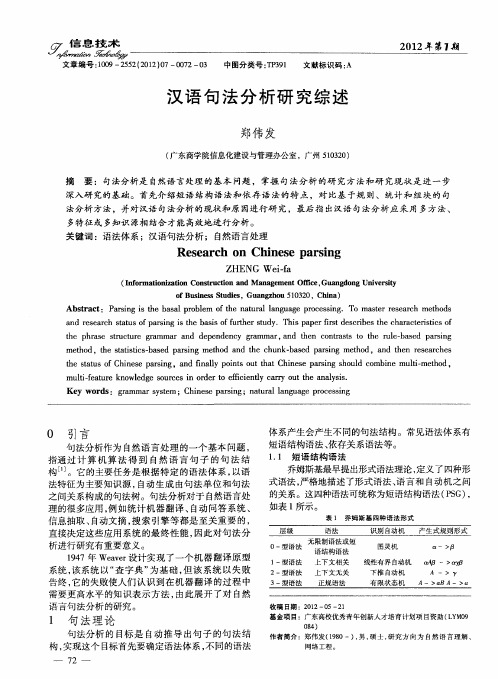
摘
要 :句法分析 是 自然语 言处理 的基 本 问题 ,掌握 句法 分析 的研 究方 法和研 究现 状是 进 一 步
深入 研 究的基础 。首先介 绍短 语 结构 语 法 和依 存语 法 的特 点 ,对 比基 于规 则、统 计 和组 块 的 句
法分析 方法 ,并对汉语 句 法分 析 的现 状和原 因进 行研 究 ,最后 指 出汉语 句法分 析应 采 用 多方 法 、 多特征 或 多知识 源相 结合 才能 高效地进行 分析 。
表 1 乔 姆 斯 基 四种 语 法 形 式
收稿 日期 :2 1 0 0 2— 5—2 1
K e r s: g a ma y tm ;Chi s a sn y wo d rm r s se ne e p r i g;n t a a g a e p o e sn aurlln u g r c s ig
0 引 言
句法 分析作 为 自然 语 言 处理 的一个 基 本 问题 , 指 通 过 计 算 机 算 法 得 到 自然 语 言 句 子 的句 法 结 构 J 。它 的主要 任务是 根 据 特定 的语法 体 系 , 以语 法特征 为主要 知识 源 , 自动 生 成 由句 法 单 位 和句 法 之 间关 系构成 的句法 树 。句 法分析 对于 自然语 言处 理 的很 多应用 , 如统 计 机器 翻译 、 例 自动 问答 系 统 、 信 息抽 取 、 自动文 摘 , 索 引擎 等 都是 至关 重 要 的 , 搜 直接决 定这 些应用 系 统 的最 终 性 能 , 因此 对 句法 分 析进行 研究 有重要 意义 。 14 97年 Wevr 计实 现 了一 个 机器 翻 译原 型 ae设 系统 , 系统 以 “ 字典 ” 基 础 , 该 查 为 但该 系统 以失 败 告终 , 的失败使 人们 认 识 到在 机 器 翻译 的过 程 中 它 需要 更高水 平 的知识 表 示方 法 , 由此 展开 了对 自然 语 言句法 分析 的研 究 。
句法结构研究范文
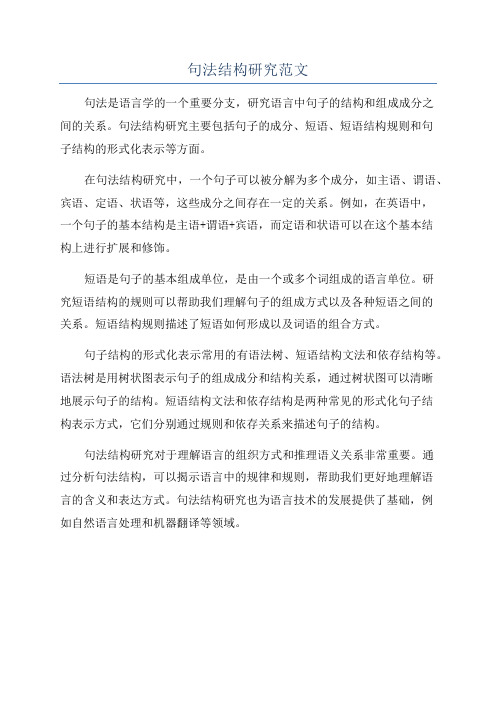
句法结构研究范文
句法是语言学的一个重要分支,研究语言中句子的结构和组成成分之
间的关系。
句法结构研究主要包括句子的成分、短语、短语结构规则和句
子结构的形式化表示等方面。
在句法结构研究中,一个句子可以被分解为多个成分,如主语、谓语、宾语、定语、状语等,这些成分之间存在一定的关系。
例如,在英语中,
一个句子的基本结构是主语+谓语+宾语,而定语和状语可以在这个基本结
构上进行扩展和修饰。
短语是句子的基本组成单位,是由一个或多个词组成的语言单位。
研
究短语结构的规则可以帮助我们理解句子的组成方式以及各种短语之间的
关系。
短语结构规则描述了短语如何形成以及词语的组合方式。
句子结构的形式化表示常用的有语法树、短语结构文法和依存结构等。
语法树是用树状图表示句子的组成成分和结构关系,通过树状图可以清晰
地展示句子的结构。
短语结构文法和依存结构是两种常见的形式化句子结
构表示方式,它们分别通过规则和依存关系来描述句子的结构。
句法结构研究对于理解语言的组织方式和推理语义关系非常重要。
通
过分析句法结构,可以揭示语言中的规律和规则,帮助我们更好地理解语
言的含义和表达方式。
句法结构研究也为语言技术的发展提供了基础,例
如自然语言处理和机器翻译等领域。
自然语言处理中的句法分析方法研究
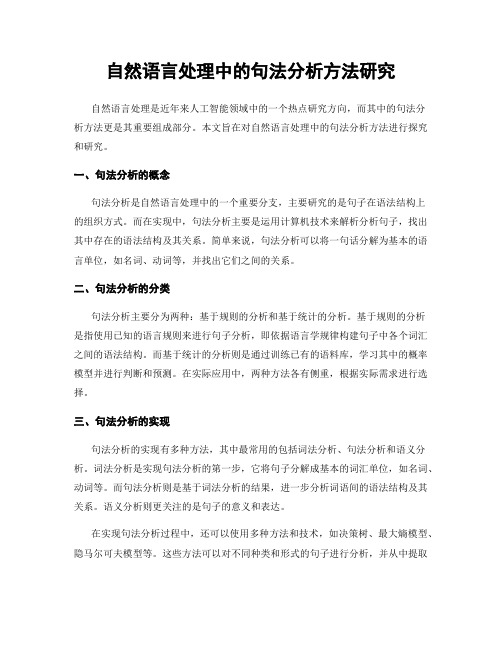
自然语言处理中的句法分析方法研究自然语言处理是近年来人工智能领域中的一个热点研究方向,而其中的句法分析方法更是其重要组成部分。
本文旨在对自然语言处理中的句法分析方法进行探究和研究。
一、句法分析的概念句法分析是自然语言处理中的一个重要分支,主要研究的是句子在语法结构上的组织方式。
而在实现中,句法分析主要是运用计算机技术来解析分析句子,找出其中存在的语法结构及其关系。
简单来说,句法分析可以将一句话分解为基本的语言单位,如名词、动词等,并找出它们之间的关系。
二、句法分析的分类句法分析主要分为两种:基于规则的分析和基于统计的分析。
基于规则的分析是指使用已知的语言规则来进行句子分析,即依据语言学规律构建句子中各个词汇之间的语法结构。
而基于统计的分析则是通过训练已有的语料库,学习其中的概率模型并进行判断和预测。
在实际应用中,两种方法各有侧重,根据实际需求进行选择。
三、句法分析的实现句法分析的实现有多种方法,其中最常用的包括词法分析、句法分析和语义分析。
词法分析是实现句法分析的第一步,它将句子分解成基本的词汇单位,如名词、动词等。
而句法分析则是基于词法分析的结果,进一步分析词语间的语法结构及其关系。
语义分析则更关注的是句子的意义和表达。
在实现句法分析过程中,还可以使用多种方法和技术,如决策树、最大熵模型、隐马尔可夫模型等。
这些方法可以对不同种类和形式的句子进行分析,并从中提取出有用的信息和结构。
其中,最大熵模型是最常用的方法之一,它可以对句子的各项特征进行权重分配,从而实现准确的句法分析。
四、句法分析的应用句法分析可以应用于多个领域,最常见的应用是在计算机和自然语言交互中。
在这种情况下,句法分析可以帮助计算机解析用户输入的语言,识别其中存在的语法结构和意思。
此外,句法分析还可以应用于机器翻译、问答系统、文本分类等多个领域。
五、句法分析面临的挑战句法分析虽然在近年来有了很大的进展,但仍面临一些挑战。
其中最主要的挑战在于处理自然语言的歧义性。
语言学中的句法学研究进展

语言学中的句法学研究进展引言语言是人类交流和表达思想的重要工具,句法学作为语言学的一个重要分支,研究的是句子的结构和组织规则。
随着科技的进步和语言学研究的深入,句法学的研究也取得了长足的进展。
本文将从句法关系、短语结构和语法模型三个方面来探讨语言学中句法学的研究进展。
句法关系的研究进展句法关系是句法学研究的核心内容,也是理解句子结构的基础。
传统的句法关系包括主语、谓语、宾语等,但随着研究的深入,还出现了更多的句法关系,如状语、定语、补语等。
近年来,研究者们通过语料库分析、实证研究等方法,进一步揭示了句法关系的各种细微差别和变化规律。
另外,句法关系的研究也逐渐涉及到跨语言和比较语法的领域。
研究者们发现,不同语言之间的句法关系存在着差异,这不仅仅是表面上的词序和语序的差异,还包括结构上的差异。
比较语法的研究,使我们对语言差异的本质有了更深刻的认识,并为翻译和语言教学等领域提供了重要的参考。
短语结构的研究进展短语结构是句法学中的另一个重要研究内容。
传统的短语结构一般分为名词短语、动词短语等,但随着研究的深入,研究者们发现短语结构不仅仅是简单的组合,还存在着多层次和交互作用的结构。
在这个基础上,一些新的短语结构理论也应运而生。
其中,基于X-bar理论的短语结构分析成为主流。
X-bar理论认为,短语结构具有层级结构,其中X代表一个种类的短语(如NP代表名词短语),而-bar表示衍生的原因。
通过X-bar理论,我们可以更准确地描述和分析句子的结构,从而深入理解句法关系的内在规律。
语法模型的研究进展语法模型是句法学研究中的另一个重要方面,它试图通过形式化的方法来描述和解释句子的结构和规则。
传统的语法模型主要有短语结构语法和依存语法。
短语结构语法关注的是短语之间的组合关系,而依存语法强调的是词与词之间的依附关系。
近年来,随着计算语言学的发展,一些基于统计和机器学习的语法模型也逐渐兴起。
这些模型通过对大规模语料库的学习和训练,自动发现语言中的规律和模式,从而实现对句子结构和语法的建模。
关于句法研究的思考
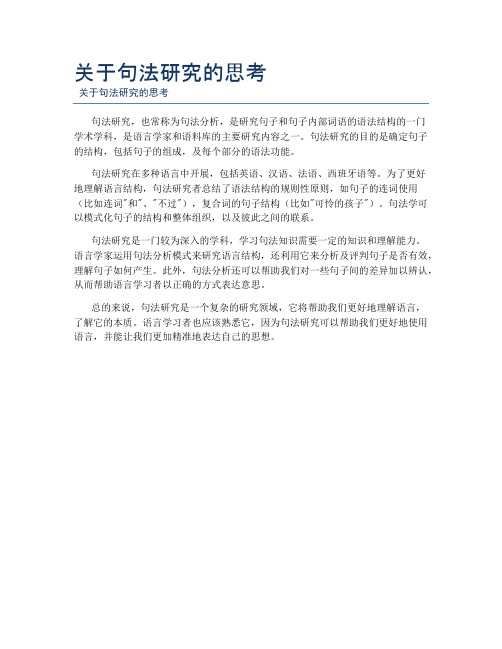
关于句法研究的思考
关于句法研究的思考
句法研究,也常称为句法分析,是研究句子和句子内部词语的语法结构的一门
学术学科,是语言学家和语料库的主要研究内容之一。
句法研究的目的是确定句子的结构,包括句子的组成,及每个部分的语法功能。
句法研究在多种语言中开展,包括英语、汉语、法语、西班牙语等。
为了更好
地理解语言结构,句法研究者总结了语法结构的规则性原则,如句子的连词使用(比如连词"和"、"不过"),复合词的句子结构(比如"可怜的孩子")。
句法学可以模式化句子的结构和整体组织,以及彼此之间的联系。
句法研究是一门较为深入的学科,学习句法知识需要一定的知识和理解能力。
语言学家运用句法分析模式来研究语言结构,还利用它来分析及评判句子是否有效,理解句子如何产生。
此外,句法分析还可以帮助我们对一些句子间的差异加以辨认,从而帮助语言学习者以正确的方式表达意思。
总的来说,句法研究是一个复杂的研究领域,它将帮助我们更好地理解语言,
了解它的本质。
语言学习者也应该熟悉它,因为句法研究可以帮助我们更好地使用语言,并能让我们更加精准地表达自己的思想。
汉语句法的灵活性和句法理论

通过对源语言和目标语言之间句法规则的对比和分析,可以构建出更为准确 的机器翻译模型。在文本分析方面,汉语句法研究为文本的结构和语义分析提供 了有力工具。例如,通过分析文章中的句子结构和语义关系,可以得出文章的主 旨和作者的观点。
然而,汉语句法在应用中也存在一定的挑战。首先,汉语句法的复杂性使得 机器学习和自然语言处理技术的效果受到限制。例如,这些技术往往难以正确处 理复杂的句子结构和语义关系。其次,不同领域对汉语句法的需求和应用也存在 差异。
汉语句法的灵活性和句法理论
01 引言
03 句法理论 05 结论
目录
02 汉语句法的灵活性 04 应用探讨
引言
汉语句法研究是汉语语言学的重要组成部分,句法的灵活性为其主要特点。 这种灵活性体现在句型、句类、时态等多个方面,为汉语表达提供了丰富的手段。 本次演示旨在探讨汉语句法的灵活性和句法理论,以深入理解汉语语言学的内涵 和应用。
经典句法理论注重句子结构的分析,认为句子结构是语法研究的核心。这种 理论通过研究句子中词语之间的依存关系和句法成分的组合规律,来揭示汉语句 法的内在逻辑。深层句法理论则强调语义因素在句法研究中的重要性,认为语义 是句子结构的内在驱动力。这种理论通过分析词语之间的语义关系和语义结构, 来揭示汉语句法的语义基础。
汉语句法的灵活性
汉语句法的灵活性表现在多个方面。首先,从句型来看,汉语句法拥有丰富 的句型,如主谓结构、动宾结构、主从结构等,这些句型可以根据表达的需要进 行灵活组合和变换。其次,从句类来看,汉语句法包含了陈述句、疑问句、祈使 句和感叹句等多种句类,每种句类都有其独特的表达方式和语用功能。
此外,从时态来看,汉语句法通过动词的变形、助词的添加等方式来表达时 态,如进行时、完成时等,这些时态在表达时间关系和语用意图方面具有重要作 用。
英语小句句法结构研究
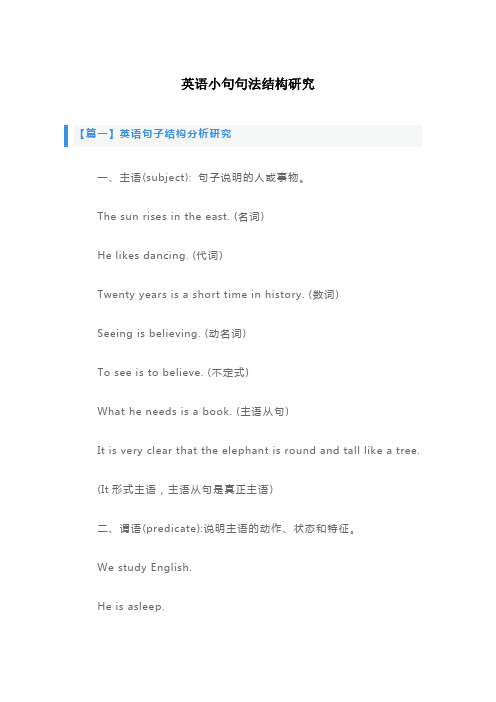
英语小句句法结构研究【篇一】英语句子结构分析研究一、主语(subject): 句子说明的人或事物。
The sun rises in the east. (名词)He likes dancing. (代词)Twenty years is a short time in history. (数词)Seeing is believing. (动名词)To see is to believe. (不定式)What he needs is a book. (主语从句)It is very clear that the elephant is round and tall like a tree.(It形式主语,主语从句是真正主语)二、谓语(predicate):说明主语的动作、状态和特征。
We study English.He is asleep.三、表语(predicative):系动词之后的成分,表示主语的性质、状态和特征。
He is a teacher. (名词)Seventy-four! You don’t look it. (代词)Five and five is ten. (数词)He is asleep. (形容词)His father is in. (副词)The picture is on the wall. (介词短语)My watch is gone / missing / lost. (形容词化的分词)To wear a flower is to say “I’m poor, I can’t buy a ring. ”(不定式)The question is whether they will come. (表语从句)常见的系动词有: be, sound(听起来),look(看起来),feel(摸起来),smell(闻起来),taste(尝、吃起来),remain(保持,仍是),feel(感觉) ….It sounds a good idea.The sound sounds strange.Her voice sounds sweet.Tom looks thin.The food smells delicious.The food tastes good.The door remains open.Now I feel tired.三、宾语:1)动作的承受者——动宾I like China. (名词)He hates you. (代词)How many do you need? We need two. (数词) We should help the old and the poor.I enjoy working with you. (动名词)I hope to see you again. (不定式)Did you write down what he said? (宾语从句)2)介词后的名词、代词和动名词——介宾Are you afraid of the snake?Under the snow, there are many rocks.3) 双宾语——间宾(指人)和直宾(指物)He gave me a book yesterday.Give the poor man some money.【篇二】英语句子结构分析研究一、宾补:对宾语的补充,全称为宾语补足语。
- 1、下载文档前请自行甄别文档内容的完整性,平台不提供额外的编辑、内容补充、找答案等附加服务。
- 2、"仅部分预览"的文档,不可在线预览部分如存在完整性等问题,可反馈申请退款(可完整预览的文档不适用该条件!)。
- 3、如文档侵犯您的权益,请联系客服反馈,我们会尽快为您处理(人工客服工作时间:9:00-18:30)。
The term transformational-generative grammar was introduced into linguistics in the mid-1950s by Noam Chomsky. Chomsky is much interested in the study of the similarities between languages rather than their differences. He holds the view that linguists should first attempt to find a grammatical framework which will be suitable for all languages. Secondly within this framework, they should concentrate not so much on elements that actually occur in all languages; thirdly, there are likely to be universal constraints on the ways in which linguistic elements can be combined. Competence / performance Internalised set of rules / actual utterances
Assignment Chapter One 1. What are properties/ design features of language? 2. What is pragmatics? What is sociolinguistics? What is applied linguistics? 3. Can you list some general functions of language? Try to provide some examples to illustrate your points.
It is believed that phrase structural rules, with the insertion of the lexicon, generate sentences at the level of D-structure, while application of syntactic movement rules transforms a sentence from the level of Dstructure to that S-structure. Phrase Structure Rules + the Lexicon D-structure Movement rules S-strue structure He is anxious to teach. He is difficult to teach. They have a similar surface structure, but different deep structure. This can be illustrated by tree diagram. Definitions (p111; p112) Deep structure contains all the units and relationships that are necessary for interpreting the meaning of the sentence. Surface structure is that of the sentence as it is pronounced or written.
Concord and Government (一致和支配) Grammatical concord (p. 109) Notional concord, e.g. Fifteen miles seems/seem like a long walk to me. Principle of proximity Not only his children but he himself is/are hoping to be there. Pronoun concord Every passenger has to carry his own luggage. Nobody wants to go there, does he?/do they? What they want are promises. What I say and think are no business of yours.
Transformational aspect This is largely concerned with the analysis of sentences and the relationship between them. Simply put, transformation refers to a kind of process that transforms one sentence into another. There are plenty of sentences in English which are related. Pairs of active and passive sentences Affirmative and interrogative sentences e.g. John saw Mary. Did John see Mary?
Transformation 1 Deletion This function is clearly illustrated by the imperative transformation. You will be quiet is transformation into Be quiet. Here you and will are assumed to exist only in deep structure. Deep structure: someone must help Mary. After T-passive: Mary must be helped by someone (an optional indefinite agent).
2 Copying This can be illustrated by tag transformation. He is coming, isn’t he? 3. Addition You have read the story, have not you? 4. Reordering He goes home on Sundays. On Sundays he goes home.
PS-rules, phrase structure rules, rewrite rules S NP VP VP V NP NP DET N DET the, a, any, some, etc. N boy, man, ball, book, etc. NP Det N (a / the man) the man that wears glasses a tall man with glasses the tall man with glasses that I met VP V S (think that he should buy an English book) advise him in a writing class that he should buy an English dictionary)
Generative aspect This means that a grammar must ‘generate all and only the grammatical sentences of a language’. In other words, the grammar must be so designed that by following its rules and conventions we could produce all or any of the possible sentences of language. A generative grammar is not concerned with any actual set of sentences of the language, but with the possible set of sentences. It has a finite number of rules which allow us to generate a infinite number of sentences of the language.
